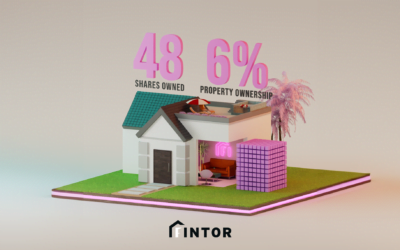Learn the differences, definitions, and formulas between levered returns and unlevered returns. When analyzing a potential real estate investment, it’s important to use the right financial metrics. Discover why thousands of investors apply leverage to their investments.
Understanding Real Estate Returns
Real estate is one of the most sought after investment categories [link to why-invest-real-estate]. That’s because owning real estate properties is a great way to generate monthly income and the asset value generally increases in value over time.
In order to compare different real estate properties, we need to look at the most common definitions and formulas used by professionals.
This guide will explore the concept of leverage, returns with leverage, and what happens to returns when you don’t utilize leverage. For more information, check out our other real estate guides.
What is Leverage?
Leverage is the use of borrowed money to increase the potential return of a specific investment and decrease the amount of money you need to purchase a property. Specifically in real estate, leverage means borrowing money from a lender to help fund the purchase of a property.
Instead of paying all cash out of pocket for a $200,000 property, an investor may want to only put $50,000 down and borrow $150,000 from the bank.
The bank loan typically comes with monthly interest attached, which lowers the property’s net operating income (NOI). NOI as a reminder is the amount of profit generated each month by the property.
Despite the cost of taking on a loan, the return on the project may still be higher with debt than without. Let’s explore how the return changes with leverage.
456 Ocean Blvd. Investment
- Property value = $200,000
- Down payment = $50,000
- Loan amount = $150,000
- Rent income (monthly) = $1,500
- Loan payment including interest (monthly) = $500
- Operating expenses (monthly) = $800
- Net operating income = $200
Return without Leverage
Let’s calculate the one year return for the property by multiplying the monthly values into annual values. Without the loan, every year the property generates $18,000 in income and $9,600 in expense.
Unlevered Yield = Net Operating Income / Total Cost
Unlevered Yield = ($18,000 – $9,600) / $200,000
Unlevered Yield = $7,800 / $200,000
Unlevered Yield = 0.039
Unlevered Yield = 3.90%
Return with Leverage
With the loan, every year the property generates $18,000 in income and $15,600 in expense.
Levered Yield = Cash Flow after Debt Service / Down Payment
Levered Yield = ($18,000 – $15,600) / $50,000
Levered Yield = $2,400 / $50,000
Levered Yield = 0.048
Levered Yield = 4.80%
Notice how the income drops significantly with the loan but the cash consideration dropped even further, which is why the return with leverage is higher than without the loan.
Utilizing Cap Rate
Capitalization rate (“cap rate”) is a key metric that investors track when evaluating potential real estate investments or measuring the performance of their existing portfolio.
Cap rate is the rate of return expected from the income that a property generates. The cap rate formula is:
Cap Rate = Net Operating Income / Current Market Value
For example, if a property generates $70,000 of net operating income (NOI) per year and is valued at $1,000,000, the property has a 7% cap rate.
The cap rate formula is always net operating income divided by the current market value of a property. For the numerator, here are typical income and expenses for a property: rental income, property tax, insurance, property management fees, and repairs.
As the property’s current value changes, the denominator of cap rate will change as well. It’s typical to assess the value of a real estate portfolio on a quarterly basis to ensure the cap rate is still accurate.
Utilizing Yield
Yield is another financial metric based on the income generated by a property. There are two definitions of yield, depending on whether or not we are evaluating the impact of leverage.
Unlevered Yield = Net Operating Income / Total Cost
Levered Yield = Cash Flow after Debt Service / Down Payment
To better understand these differences, let’s walk through an example starting with the unlevered returns.
123 Main St. Investment
- Purchase price: $500,000
- Loan amount: $350,000
- Net operating income (annual): $40,000
- Cash flow after debt (annual): $30,000
If the property is purchased without debt, then the full purchase must be paid for with the investor’s equity. In our case, that’s $500,000. And because there is no loan, there are no monthly loan payments, which means there would be higher cash flow.
Unlevered Yield = Net Operating Income / Total Cost
Unlevered Yield = $40,000 / $500,000
Unlevered Yield = 0.08
Unlevered Yield = 8.0%
The property at 123 Main St. will return 8% per year without using leverage. Now let’s dive into how leverage changes the situation.
Levered Yield = Cash Flow after Debt Service / Down Payment
Levered Yield = $30,000 / ($500,000 – $350,000)
Levered Yield = $30,000 / $150,000
Levered Yield = 0.20
Levered Yield = 20.0%
For the levered results, there is less cash flow ($30,000 compared to $40,000) and significantly less capital invested ($150,000 compared to $500,000). If the debt is too expensive (e.g., the interest rate is too high), there might be little to no difference between the return with or without leverage.
Levered vs. Unlevered Capital Appreciation
Leverage also changes the equity value of an investment. Let’s walk through this example of a property purchased for $150,000 with and without debt.
765 Waterfront Ct. Investment
- Purchase price: $150,000
- Down payment: $50,000
- Capital appreciation: 5%
Without debt, the property was purchased with $150,000 of cash. After one year, the property appreciated 5% and the owner now has $157,500 of equity.
With debt, the property was purchased with $50,000 of cash. After one year, the property appreciated 5% to $157,500. Since the loan doesn’t increase in value over time, all of that $7,500 gain is attributed to the equity owner.
A $7,500 gain on a $50,000 initial investment is a 15% one-year return. This is great news in this case, but the same news applies if a property declines in value too.
Remember that debt amplifies the positive – and negative – change in equity value!
Conclusion
Leverage is the use of borrowed money to increase the potential return of an investment. In real estate, investments are typically purchased with 50-80% debt to amplify the returns.
If the cost of capital is low, it’s possible to improve the overall project’s return significantly. That being said, if the cost of capital is too high, there may be little to no difference between the returns with or without debt.
When calculating the return without leverage, you should use net operating income (NOI) divided by the total property cost. When calculating the return with leverage, you want to take NOI and add the debt service costs, which will decrease the numerator.
By the same token, you do not use the full purchase price as the denominator. You only use your cash down payment.
Keep in mind that leverage can also make a bad investment worse, so it’s a double edged sword.



